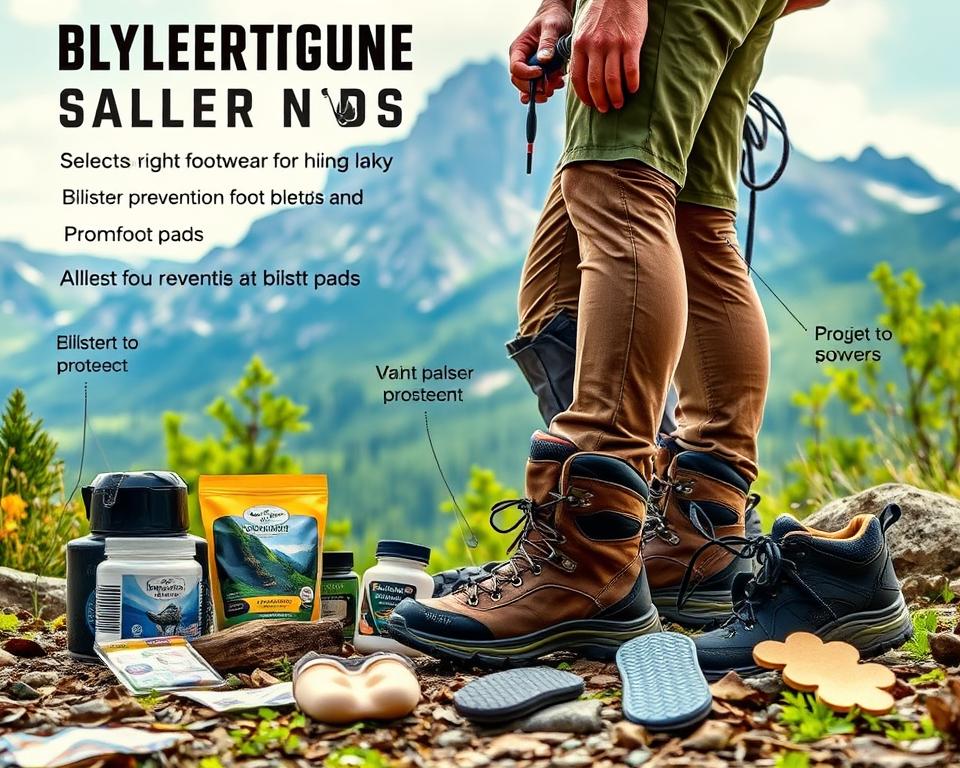If you’ve ever been hiking and ended up with painful blisters, you understand the importance of preventing them. I’ve learned how vital it is to keep feet blister-free through my own trail experiences. Here are some key tips to help your feet stay ready for whatever comes next.
Knowing why blisters happen is key to stopping them. Friction, heat, and moisture are the main culprits behind blisters. Making sure your hiking boots or shoes fit well is important. Ill-fitting footwear almost always leads to blisters. Breaking in your boots before a big hike can prevent a lot of pain later.
Trying out different ways to tie your shoes can also help a lot. For instance, a double surgeon’s knot can lessen pressure points that cause blisters. This little change in tying your shoes can make your hike much more comfortable.
Choosing the right socks, such as Injinji toe socks, can cut down on friction and moisture. These are two big things that cause blisters. Drying your feet during breaks and using sock liners that wick away moisture can keep them from getting too wet inside your shoes.
It’s smart to act early by taping spots that feel hot before they turn into blisters. Using Leukotape is a trick many hikers use. After hiking, it’s good to let your feet air out. Swap into different shoes and take care of any spots that might turn into blisters.
For those on long hikes, using these tips can help you finish your journey without much foot pain. So, make sure your shoes are tied right, wear the correct socks, and keep your feet dry. Follow these steps for a hike without blisters!
Understanding the Causes of Blisters
First, let’s talk about why blisters happen. They are usually caused by rubbing, heat, and dampness. Wearing shoes and socks that don’t fit well can make it worse. These issues can turn a nice hike into a painful one.
Friction and Irritation
Friction and irritation are the top reasons for blisters. Shoes that don’t fit right cause pressure and rubbing. This can lead to blisters, which hurt. It’s important to wear shoes that fit well to prevent this.
Make sure your boots aren’t too tight. Tight boots can cause more rubbing.
Heat and Moisture
Heat and dampness can also lead to blisters. They make your feet sweat and swell, which increases friction. Wearing socks that keep heat and moisture can make things worse. It’s key to keep your feet dry and cool.
High shoe temperatures and too much dampness can make blisters more likely. It becomes harder to keep blisters away.
The Role of Footwear and Socks
Shoes and socks are very important in preventing blisters. The right boots and socks that wick away moisture can really help. Look for boots with space for your toes and maybe add sock liners for extra protection.
Brands like Wrightsock make socks that prevent blisters. They use a double-layer to protect your feet. Choosing the right gear is about comfort and avoiding blisters.
For more tips on keeping blisters at bay, check out this detailed guide.
Choosing the Right Hiking Boots
The journey to avoid blisters starts with picking the right hiking boots. Getting a hiking boot that fits well is key for comfort on long walks. It’s best to try boots on at a store and do a ramp test to make sure they fit right.
Proper Boot Fit
Choosing the correct hiking boots is crucial. Brands like Oboz, Keen, and Merrell are good for different foot shapes. This helps to prevent blisters. Wearing wool or synthetic socks, like those from Darn Tough, also helps keep feet dry and blister-free. Check out this guide to happy feet for more tips.
Breaking in Your Boots
It’s important to break in boots before long hikes. This makes the boots more comfortable and reduces blister risk. For tough boots, breaking them in is really crucial. But, many new boots are designed to need less breaking in. Keeping waterproof boots clean helps them stay waterproof.
Remember, keeping your feet dry is key to preventing blisters. So, dry feet mean happy hiking.
Lacing Techniques
Knowing how to lace your boots can prevent fit problems like heel slipping. Different lacing tricks can help you get the best fit. Paying attention to how your boots lace up can greatly improve your hiking experience and help avoid blisters.
How to Prevent Blisters When Hiking
When you go hiking, avoiding blisters means choosing the right gear and taking care of your feet. Here are tips to protect your feet on your next trip.
Invest in Quality Hiking Socks
Many hikers get blisters, but quality hiking socks can change that. These socks have extra padding where you need it most, like heels and toes. They also move moisture away from your skin. I prefer brands like Smartwool and Darn Tough, which help keep my feet comfy and dry. The right socks reduce rubbing and stop those painful spots that turn into blisters.
Use Sock Liners and Foot Powder
Add sock liners and foot powder for hiking to your gear to lower blister risk. Liners pull moisture away, stopping sweat from causing friction. Injinji Liners are great for keeping feet dry. Also, Gold Bond Powder can help a lot. It cuts down on rubbing and keeps feet dry. Using these can make hiking more enjoyable and blister-free.
Keep Feet Dry and Cool
To avoid blisters, it’s key to keep your feet dry and cool. If you’re hiking a long way, you might need to change socks if they get wet. Socks that wick away moisture are a must. Also, let your feet breathe during breaks. Shoes with good ventilation help too.
If some spots on your feet often get blisters, cover them with Leukotape before you start your hike. These steps can really protect your feet from blisters.
- Invest in high-quality hiking socks with extra cushioning.
- Use sock liners for added moisture control and reduced friction.
- Apply foot powder to keep feet dry and minimize blister formation.
- Change socks during long hikes and let feet air out regularly.
- Cover problem areas with Leukotape to prevent blisters in prone spots.
Following these tips will help you hike with less worry about blisters. Enjoy the trails!
What Are the Best Techniques to Prevent Blisters While Hiking?
To prevent hiking blisters, choose well-fitted footwear and moisture-wicking socks. Ensure that your shoes are broken in before lengthy hikes to reduce friction. Applying blister prevention tape on pressure points can also help. Stay dry and take regular breaks to allow your feet to breathe and recover.
Additional Blister Prevention Tips
Besides the essential steps already shared, you’ve got more options to avoid blisters while hiking. It’s important to keep your boots free from debris, manage how much you hike, and tape up areas that often give you trouble. These steps are all essential for keeping blisters at bay.
Keep Debris Out with Gaiters
Things like small stones and twigs can sneak into your boots and rub your feet the wrong way. This can cause blisters. Using low gaiters can stop this from happening. They cover the top of your boots and your lower legs, keeping stuff from outside from getting in. This helps you steer clear of extra friction and keeps your hike comfy.
Gradually Build Up Hiking Mileage
To dodge blisters, it’s smart to slowly get your feet used to walking long distances. Increasing your hike distance little by little makes your feet’s skin tougher. This lessens your chances of getting blisters. Begin with short walks and slowly extend your distance. This lets your feet adjust without overwhelming them and causing blisters.
Pre-Taping Problem Areas
Knowing where you usually get blisters lets you preemptively take action. Taping these spots with Leukotape or KT tape is a smart move. It shields areas that tend to blister before you even start hiking. This tape works as a barrier that lessens rubbing. It’s a great way to stop blisters before they can start.

